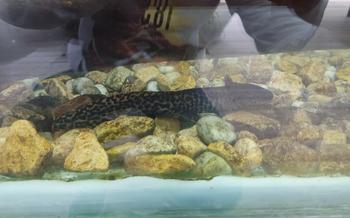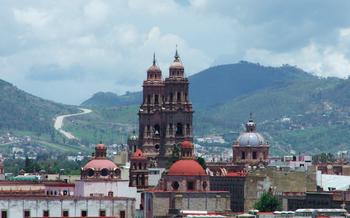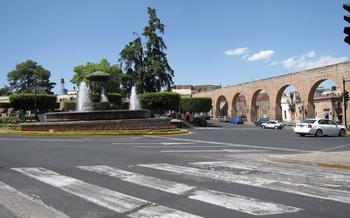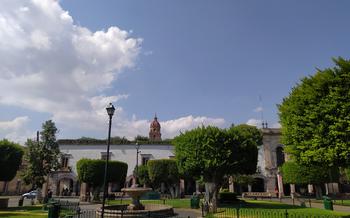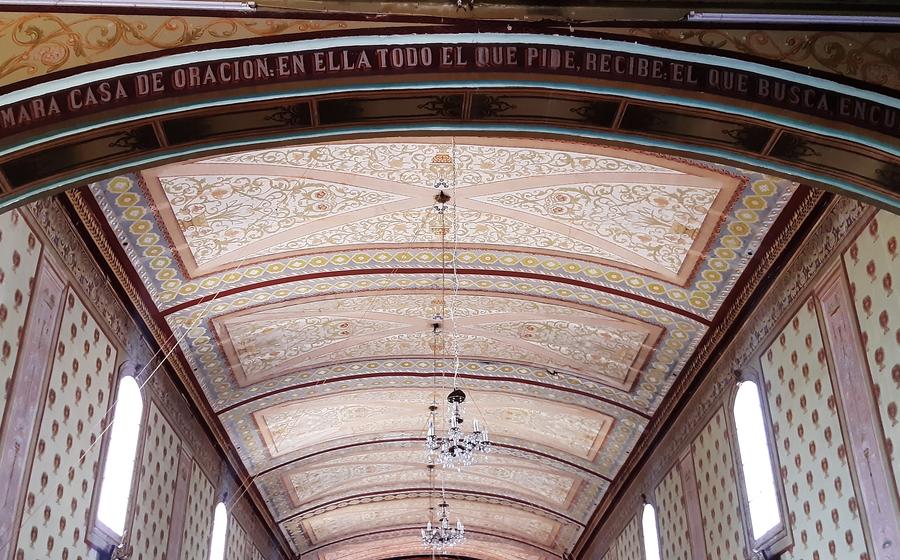
Orquidario de Morelia
- The Orquídario de Morelia: A Unique Experience
- History of the Orquidario de Morelia
- The Orquídeas: Breathtaking Beauties
- The Gardens: A Tropical Paradise
- Exploring the Orquídeas: A Guided Tour
- Tips for Visiting the Orquidario de Morelia
- The Orquidario as an Educational Resource
- Botanical Garden or Orchidarium?
- Ecological Importance of the Orquídeas
- The Orquídario de Morelia and Sustainable Tourism
- Getting to the Orquídario de Morelia
- Hours of Operation and Admission Fees
- Insider Tip: Capture the Beauty of the Orquídeas
The Orquídario de Morelia: A Unique Experience
The Orquidario de Morelia is a captivating oasis dedicated to the wonders of orchids, located in the heart of Morelia, Mexico. Whether you're a nature enthusiast, a gardening aficionado, or simply seeking a serene escape, this remarkable sanctuary promises an unforgettable experience. Immerse yourself in the vibrant world of orchids, marvel at their breathtaking beauty, and discover the fascinating stories behind these exquisite blooms.
Why is it a must-visit for nature lovers?
Nature enthusiasts will find paradise within the Orquidario de Morelia. With over 1,000 species of orchids from around the world, this haven showcases the astounding diversity of these remarkable plants. Witness the delicate petals, intricate patterns, and vibrant hues that make each orchid a masterpiece of nature. Learn about the unique adaptations and ecological roles of these captivating flowers, and gain a deeper appreciation for the intricate tapestry of life within the plant kingdom.
Where is it located?
The Orquídario de Morelia is conveniently situated in the city's historic center, allowing for easy access from various points of interest. Nestled within the lush vegetation of the Parque Zoológico Benito Juárez, the orchidarium offers a peaceful retreat from the bustling urban landscape. Take a leisurely stroll through the park, admiring the diverse flora and fauna, before stepping into the enchanting world of orchids that awaits within the orquidarium.
How much does it cost to enter?
Admission to the Orquidario de Morelia is affordably priced, making it accessible to visitors of all backgrounds. With separate ticket options for adults, children, and seniors, everyone can experience the wonders of orchids without breaking the bank. Additionally, the orquidarium offers discounts and promotions throughout the year, providing even greater value for your visit.
History of the Orquidario de Morelia
The Orquidario de Morelia, a haven for orchid enthusiasts and nature lovers alike, has a rich and storied history. Its roots can be traced back to 1967, when a group of passionate orchid lovers, led by Don Alfredo Duges, came together with a shared vision of creating a sanctuary dedicated to the preservation and appreciation of these exquisite flowers. With unwavering dedication, they established the Orquidario de Morelia, which opened its doors to the public in 197
Over the years, the orquidarium has undergone significant transformations, driven by the tireless efforts of its devoted staff and volunteers. It has evolved from a modest collection of orchids to a world-renowned institution that is recognized for its exceptional conservation, research, and educational programs. Today, the Orquidario de Morelia stands as a testament to the enduring passion and commitment of its founders, who laid the foundation for its remarkable legacy.
The Orquídeas: Breathtaking Beauties
The Orquidario de Morelia houses a diverse collection of orquídeas, each one a masterpiece of nature. From the delicate and fragrant Cattleya to the showy and flamboyant Phalaenopsis, the variety of orchids on display is simply breathtaking. Visitors can marvel at the intricate shapes and vibrant colors of these exotic flowers, from the deep purples and reds to the soft pinks and whites. The orquídeas also emit a range of intoxicating fragrances, creating a sensory experience that is both captivating and unforgettable.
The orquidarium is committed to the conservation of endangered orchid species, playing a vital role in protecting these natural treasures for future generations. Through its conservation efforts, the orquidarium contributes to the preservation of biodiversity and the maintenance of healthy ecosystems.
The Gardens: A Tropical Paradise
The Orquidario de Morelia boasts a stunning tropical garden that serves as a habitat for a diverse array of plant species. The layout of the garden is a testament to the thoughtful design and care that has gone into creating this natural oasis. Visitors are greeted by meticulously manicured pathways that wind their way through vibrant flower beds, creating a kaleidoscope of colors and textures.
The variety of tropical plants and flowers on display is truly impressive.
Exploring the Orquídeas: A Guided Tour
A guided tour of the Orquidario de Morelia is an enriching experience that allows visitors to delve deeper into the world of orchids. Guided tours are led by knowledgeable and passionate experts who share their insights on the different species, their habitats, and their ecological importance. Visitors can learn about the intricate pollination mechanisms of orchids, the significance of their conservation, and the various threats they face.
The tours provide a comprehensive overview of the orquidarium's collection, highlighting the unique features and characteristics of each orchid species. Guides point out the different colors, shapes, and sizes of the orchids, explaining the evolutionary adaptations that have enabled them to thrive in diverse environments. Visitors can also learn about the conservation efforts undertaken by the orquidarium to protect endangered orchid species and promote their sustainable cultivation.
Guided tours typically last for about an hour to an hour and a half, and the cost is included in the admission fee. Visitors can book a guided tour in advance to ensure their spot, especially if they are visiting during peak season. Group discounts may be available for larger groups or school field trips.
Taking a guided tour of the Orquidario de Morelia is a highly recommended experience for nature enthusiasts, orchid lovers, and anyone interested in learning more about the fascinating world of these magnificent plants.
Tips for Visiting the Orquidario de Morelia
To make the most of your visit to the Orquidario de Morelia, keep these tips in mind:
-
Best time to visit: The orquidarium is open year-round, but the best time to visit is during the spring (February-April) when the majority of the orchids are in bloom. The weather is also pleasant during this time, with warm days and cool nights.
-
What to wear and bring: Wear comfortable shoes as you'll be doing a lot of walking. Bring along a hat, sunglasses, and sunscreen to protect yourself from the sun. It's also a good idea to bring a water bottle, especially if you're visiting during the warmer months.
-
Accessibility: The orquidarium is wheelchair accessible, with ramps and designated parking spaces for visitors with disabilities. However, some areas of the gardens may be challenging to navigate due to uneven terrain and narrow pathways.
-
Pet policy: Pets are not allowed inside the orquidarium.
The Orquidario as an Educational Resource
The Orquidario de Morelia is not just a place of beauty and wonder, but also a valuable educational resource. The orchidarium offers a range of educational programs and workshops designed to teach visitors about the fascinating world of orchids and their importance in the ecosystem. Guided tours are available for school groups, providing students with an opportunity to learn about plant science, conservation, and the role of orchids in the environment.
In addition to educational programs, the orquidarium also conducts important conservation research. Scientists at the orchidarium study the genetics, ecology, and conservation status of various orchid species, contributing to the preservation of these beautiful and endangered plants. The orquidarium also collaborates with other botanical institutions around the world, sharing knowledge and resources to promote orchid conservation and research.
Botanical Garden or Orchidarium?
While often used interchangeably, botanical gardens and orchidariums are distinct entities with unique characteristics. Botanical gardens typically encompass a wider range of plant species, including trees, shrubs, flowers, and grasses, while orchidariums focus specifically on the cultivation and display of orchids. This specialization allows orchidariums to provide a more immersive and comprehensive experience for orchid enthusiasts.
Visiting both types of institutions offers complementary experiences. Botanical gardens offer a broader perspective on plant diversity, showcasing the intricate relationships between different species and their ecological significance. Orchidariums, on the other hand, provide a deeper dive into the world of orchids, allowing visitors to admire the incredible variety of these captivating flowers and learn about their unique adaptations and conservation status.
In Morelia, visitors can explore both botanical gardens and orchidariums to gain a comprehensive understanding of the region's rich plant life. The Jardín Botánico de Morelia, located in the heart of the city, showcases a diverse collection of plants from around the world, including a section dedicated to orchids. The Orquidario de Morelia, on the other hand, is entirely dedicated to orchids, offering a breathtaking display of these exquisite flowers in a serene and tropical setting.
Ecological Importance of the Orquídeas
Beyond their aesthetic beauty, the orchids housed in the Orquidario de Morelia play a crucial ecological role. As essential components of their native ecosystems, these plants engage in intricate relationships with other organisms. They serve as a significant food source for pollinators such as bees, butterflies, and moths, as well as providing shelter and nesting sites for a variety of insects and small animals.
The orchids' unique adaptations, such as their intricate flower structures and specialized reproductive strategies, contribute to the overall biodiversity of the region. By providing nectar and pollen, they help to maintain the delicate balance of the food chain, ensuring the survival and reproduction of a wide range of species.
However, the increasing threats posed by habitat loss, climate change, and illegal wildlife trade have placed orchid populations around the world in grave danger. The Orquidario de Morelia actively participates in conservation efforts to protect and preserve these vulnerable species. Through research and collaboration, the orchidarium contributes to the understanding and conservation of orchid habitats, promoting the sustainable use and enjoyment of these magnificent plants for generations to come.
The Orquídario de Morelia and Sustainable Tourism
The Orquidario de Morelia is committed to sustainable tourism practices. It has implemented several initiatives to reduce its environmental impact and promote responsible tourism. These initiatives include:
- Water conservation: The orquidarium has installed water-saving fixtures and uses recycled water for irrigation.
- Energy efficiency: The orquidarium uses energy-efficient lighting and appliances, and it has installed solar panels to generate renewable energy.
- Waste reduction: The orquidarium composts its organic waste and recycles paper, plastic, and glass.
- Education: The orquidarium offers educational programs about sustainability to visitors and the local community.
Visitors to the orquidarium can contribute to sustainable tourism by:
- Reducing their water consumption: Visitors can conserve water by taking shorter showers, turning off the water when they brush their teeth, and reusing towels.
- Conserving energy: Visitors can conserve energy by turning off lights when they leave a room, unplugging electronics when they are not in use, and using public transportation or walking instead of driving.
- Reducing their waste: Visitors can reduce their waste by bringing their own water bottles and reusable bags, and by recycling and composting their waste.
The Orquidario de Morelia has been recognized for its sustainability efforts. It has received the Green Globe certification, which is a leading international standard for sustainable tourism.
The orquidarium is committed to continuing to improve its sustainability practices. It is working to develop new ways to reduce its environmental impact and promote responsible tourism.
Getting to the Orquídario de Morelia
The Orquidario de Morelia is located in the beautiful city of Morelia, in the state of Michoacán, Mexico. The orquidarium is situated in the northwest part of the city, in the municipality of Tarímbaro. To reach the orquidarium, visitors can take a taxi or ride-sharing service, which is the most convenient and direct option. Alternatively, visitors can opt to drive their own car and follow the signs leading to the orquidarium. Ample parking facilities are available for visitors, including designated spaces for osób niepełnosprawnych. For those arriving by public transportation, there are several bus routes that stop near the orquidarium, making it easily accessible. Visitors with mobility issues can request assistance from the orquidarium staff upon arrival.
Hours of Operation and Admission Fees
The Orquidario de Morelia is open to the public from Tuesday to Sunday, from 9:00 AM to 5:00 PM. It is closed on Mondays and public holidays. Visitors can purchase tickets at the entrance gate. Ticket prices are affordable, with discounts offered for children and seniors. Advance ticket purchase options are also available online, allowing visitors to skip the line and secure their entry. Keep in mind that during peak season or special events, it is advisable to arrive early or book your tickets in advance to avoid long lines. The orquidarium's revenue from ticket sales contributes to its conservation and educational programs, ensuring the sustainability of this beautiful sanctuary for orchids.
Insider Tip: Capture the Beauty of the Orquídeas
The Orquidario de Morelia is a photographer's paradise. The vibrant colors, intricate patterns, and delicate textures of the orchids make them a delight to capture on camera. If you're interested in photography, here are a few insider tips to help you make the most of your visit:
-
Visit during the early morning or late afternoon: The soft, diffused light of these times of day will help you avoid harsh shadows and bring out the natural beauty of the orchids.
-
Use a macro lens: A macro lens will allow you to get up close and personal with the orchids, capturing the intricate details of their petals and stamens.
-
Experiment with your aperture: A wide aperture (low f-stop number) will blur the background and make your orchids stand out. A narrow aperture (high f-stop number) will keep both the orchids and the background in focus.
-
Use a tripod: A tripod will help you keep your camera steady, especially when shooting with a macro lens.
-
Compose your shots carefully: Take your time to compose your shots, paying attention to the elements of design such as color, shape, and texture. Look for interesting angles and perspectives that will make your photos stand out.
-
Share your photos: Once you've captured some stunning photos of the orquídeas, don't forget to share them with the world! Post them on social media or share them with friends and family.
